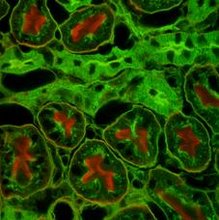AIM: to perform protein estimation by Lowry’s method.
PRINCIPLE:
Lowry’s method of protein estimation is the most widely used and accepted method for accurate determination of protein concentration. The method is a combination of biuret reaction and folin-ciocalteau reaction. In the first step of the reaction protein binds to copper in alkaline medium and produces Cu++ In the second step, Cu++ catalyses oxidation of aromatic amino acid by reducing phosphomolybdotungstate to heteropolymolybdanum blue. This reaction produces strong blue color, which predominantly depends upon tyrosine and tryptophan content of protein and to a lesser extent cysteine and other residues in protein.
PROCEDURE:
1) Pipette standard BSA (0.5 mg/ml) and test sample as given in table in duplicates.
2) Adjust the volume to 0.2 ml with distilled water.
3) Add 3 ml of complex forming reagent, mix and keep for 10 minutes.
4) Add 0.3 ml of solution III. Mix thoroughly and incubate for 20-30 minutes at room temperature.
5) Read the optical density on spectrophotometer at 660 nm or on a colorimeter using suitable filter and record the readings.
6) Plot a calibration curve by taking optical density reading on ‘y’ axis against std. Protein concentration (in mg) on ‘x’ axis.
7) Record the value X from the graph corresponding to the optical density reading for the test sample.
8) Calculate the protein concentration using the following formula.
Protein concen. In test sample = X/V (mg/ml)
Where X = value from the graph in mg.
V = volume of the sample in ml.
NOTE:
To prepare complex forming solution mix 0.5 ml of solution I and 50 ml of solution II just before use.
OBSERVATION TABLE:
RESULT:
Subscribe to:
Post Comments (Atom)


8 comments:
Really nice!
great!
Good clarity in explaining principle behind this method. I dint find it this clear and crisp in other website.Thanks. :)
I have taken total volume of BSA and water as 2ml. is that fine??
can u please tell the concentrations you have taken to draw the standard calibration curve...
the readymade kit which i gt is no doubt good but the assay protocol out there is not clear.can u make me understand this table
I am very impressed with your page… It’s very usefull… Keep it up…. Thanks..D Lactic Acid Quick Test Strips
Hi! Nice blog .You have done a great job. Keep on working.Tryptophan Assay Kit
Wow…!! It’s very interesting… I am really impressed with your post.. Thanks for sharing it..
Tryptophan Assay Kit
Post a Comment